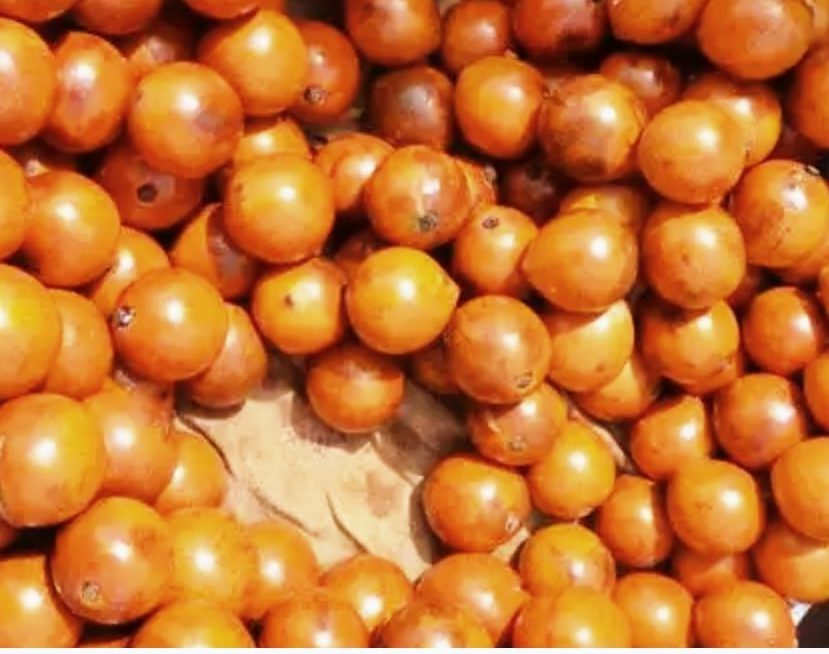Why You Should Take Enough African Cherry This Season
Do you know that fruit that the Yorubas call ‘Agbalumo’ and the Igbos call ‘Udara’? Yes, African Cherry. It is currently being displayed all over market places and street sides for sale. A sign that it is another agbalumo season. We thank God for life.
Agbalumo is botanically known as Chrysophyllum albidum, commonly known as ‘African star apple’ and belongs to the Sapotaceae family. I doubt if the kids of nowadays understand the fun part of the fruit but, throwback to 11- 15years ago, Agbalumo was indeed a star fruit. Kids used its brown hard covered seeds for very interesting games and girls used the inner whitish halves of the seed as ear adornments. The fruit also has natural chewing gum that we usually enjoy or shall I call it ‘sticky gum’? No! a gum is actually supposed to be sticky so, sticky gum is tautology.
The fruit can be gotten in most parts of Nigeria towards the end of November till March depending on seasonal fluctuation. In fact, I only just started seeing the fruit around this month. However, now that the fruit is here, how do you identify the best agbalumo in the market?
How to select ripe Agbalumo in order of occurrence.
In 2015, Observationinprogress, a food, health and travel blog identified some ways of selecting ripe agbalumo. Based on their research and according to that blog, we have:
- Size: Can be large or small as the size has little effect on the ripeness.
- Look: Should be bright orange in color. No black or grey spots. A few deep red blemishes are okay. The top should not be deep green as that means it is unripe. A pale leaf green color is okay.
- Feel: Should yield when pressed but remain firm.
- Ease of peeling: Peeling should be easily done. When peeling lengthwise, the skin should come off in 1 piece with little effort.
- Flesh color: Shiny deep red-orange color.
- Seed cluster: Strong. The five seeds should be intact and require some force to break apart. The sheath on the seed should be bright yellowish orange in color.
With that knowledge of identifying ripened African star apple, the blog went further to classify agbalumo into 6 categories among which we have the 4 listed below:

A – immature and over ripe
B – mature and ripe
C – immature and unripe
D – immature and ripe
Nutritional Benefits of Agbalumo
To be honest, I am not a fan of agbalumo. Jeeezz! I just can’t deal with that stress of trying to identify the sweet one out of so many agbalumo neither can I deal with the stress of the gum that tends to stick to my lips while I suck on the fruit. However, close to the end of the fruit’s season when there’s higher chance of not hitting my teeth on a sour African star apple, I don’t mind getting it as a gift. Because, the fruit is of immense underrated benefits and uses.
It contains rich amount of Vitamin C and serves as a good treat for healing especially in the mouth. It treats sore throat, toothache,etc. This vitamin C component also has an immune-stimulating effect which is important for defense against infections, acts as an inhibitor of a compound that is released during allergic reactions, and contains antioxidant that neutralizes harmful free radicals, pollutants and toxins.
Aside containing Vitamin C, Agbalumo could lower blood sugar and cholesterol level. It could be useful in preventing and treating heart diseases. And, like many other fruits like cashew, mango, avocado whose plant parts other than the fruit serve health purposes, the different parts of Udara like the roots, barks and leaves are used for healing cough, yellow fever, high blood pressure and much more.
In Western Nigeria, the cotyledons (that is, those two white bean shaped parts inside the hard brown seed) from the seeds are also used as ointments in the treatment of vaginal and dermatological infections.
Other gists about Agbalumo

In the previous subheading, I mentioned that the fruit’s benefits as well as uses are underrated and you probably wondered what I meant. Well, I’ve being able to do some justice to those benefits and uses but, I still emphasize that in most homes, agbalumo is underrated. Do you know that wine can be made out of agbalumo? Oh yes! shoot me! Kitchenbutterfly is working hard on some agbalumo wine and I’m like, WAWU! For a fact, she has brewed the wine already and it will probably hit the market soon. That woman is actually like a professor of agbalumo; she has a salad recipe for agbalumo, apple tart recipe, baked agbalumo, agbalumo posset, every every agbalumo recipe.

She called the juice several names such as agbalumo sour, agbalumo sling, udaratini, lumotini, amongst some others. You can check out the recipe for the cocktail or juice here.
Other health benefits of agbalumo include:
Fighting cancer and diabetes.
Weigh loss cause of it’s high fibre composition.
Serves as antibacterial.
Helps reduce menstrual cramps. It’s calcium content is the charm behind this. Calcium offers strength to the human body. The calcium embedded in the fruit can lessen symptoms of premenstrual syndrome, such as cramping and abdominal bloating. So, ladies, take enough Udara this season.





Post Comment